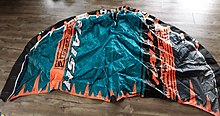Wingsurfing
The Wingsurfen is the variation of water sports, from the kite surfing , the windsurfing and stand up paddling has evolved. While standing on a board , the surfer holds a wing in his hand, which he places in the wind. In this way it generates both buoyancy and propulsion and thus moves on the water. With the development of so-called foil boards, which glide very early on a hydrofoil construction and lift out of the water, the ideal board or complementary product for the wings was created and wing foiling became rapidly popular.
Emergence
The history of wingsurfing goes back to 1986, when Tom Magruder presented his "Wind Weapon", a freely rotating sail that is firmly mounted on the surfboard. In the following years the technology is adapted and comes onto the market again and again in different versions and under new names. The use of the wings is not limited to water sports, but is also used for sports in the snow, on the beach or on land. The names "Skate Sails", "Wind Skates" or "Kitewings" are milestones in the development. Most of these variants have in common that they use a stiff frame to stretch the wing, which also function as handlebars or handles.
The reason for the moderate success of all these developments is a physical one: friction . Because wings that are big enough to set a sluggish, heavy surfboard including the surfer in motion, have to be very large, unwieldy and heavy. It was only with the introduction of foil surfing that wingsurfing experienced a renaissance, fueled by the idea of the kite brand Slingshot to transfer the production technology of kitesurfing to wingsurfing: The result was a wind wing that is inflatable, compact, light and inexpensive, and at the same time it is ahead offers a powerful propulsion especially in combination with foil boards.
This technology also impressed surf icon Robby Naish and other well-known manufacturers who are also developing inflatable wings for summer 2019.
construction
The still young sport is still developing. While older wing models were often stretched and held by means of rods, the influence of kite development is currently becoming increasingly important: The wing is made of light kite fabric that is stretched by inflatable air hoses, so-called "tubes". To grip the wing, some brands use struts with hand loops, others use telescopic aluminum rods.
Application variants
In contrast to other sports, the wing is not board-bound: you can use it not only on a surfboard, kiteboard or stand-up paddle board, but also in combination with a skateboard , snowboard , longboard or even on inline skates . Wingsurfing on boards that are equipped with a foil is particularly popular, as you can plan yourself even with small wings at around 8 knots .
Classification in the existing surfing sports
From a technical point of view, but also in terms of application, wingsurfing has numerous similarities with both windsurfing and kitesurfing. For example, the wing is controlled directly instead of via lines, but still has a similar construction and functionality to a kite. The question of whether wingsurfing is a variation of kitesurfing, windsurfing or a completely independent sport is not only theoretical: it also concerns, for example, the extent to which kite bans at the spots also apply to wing surfers . It is also discussed to what extent wing surfing as a hybrid surfing sport manages to function as a connecting element and to reduce existing rivalries between kite surfers and windsurfers.
Individual evidence
- ↑ The origin of wingsurfing, compiled by wing-surfing.de
- ↑ 5 questions about wingsurfing answered by Slingshot
- ↑ What is wingsurfing?
- ↑ Wingsufen - the end of the rivalries between windsurfers and kitesurfers?
